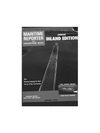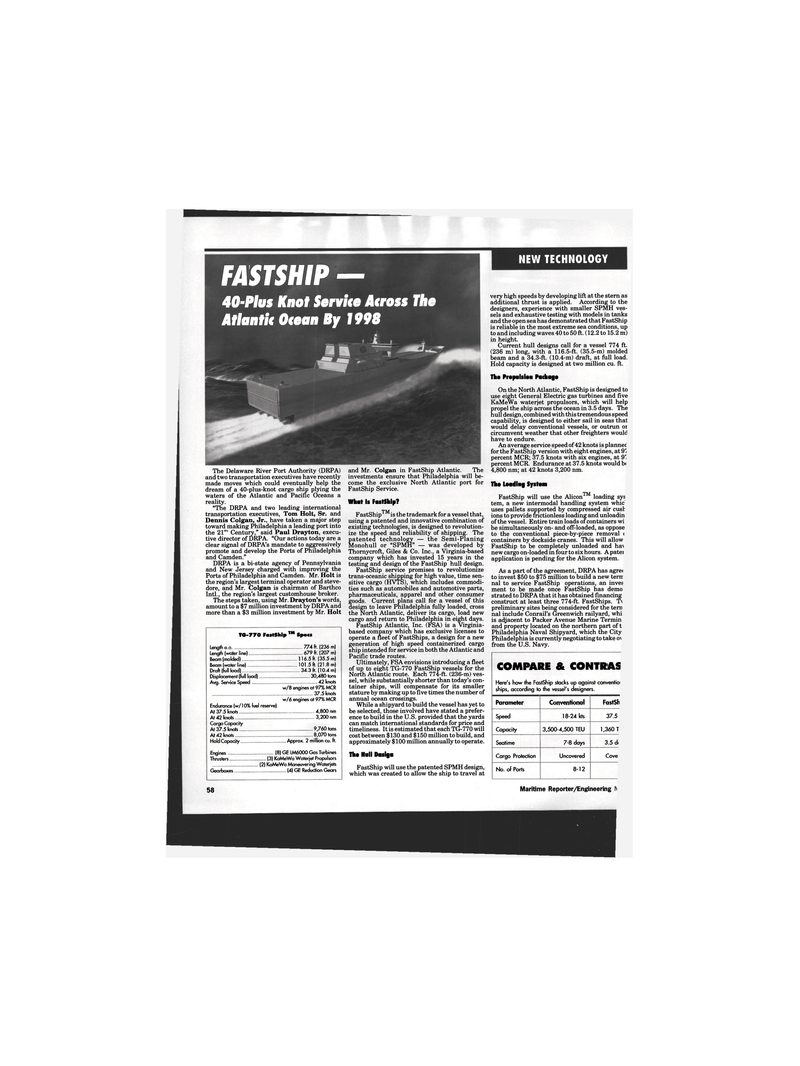
Page 76: of Maritime Reporter Magazine (August 1994)
Read this page in Pdf, Flash or Html5 edition of August 1994 Maritime Reporter Magazine
FASTSHIP — 40-Plus Knot Service Across The
Atlantic 0 NEW TECHNOLOGY
The Delaware River Port Authority (DRPA)
and two transportation executives have recently
made moves which could eventually help the
dream of a 40-plus-knot cargo ship plying the
waters of the Atlantic and Pacific Oceans a
reality.
"The DRPA and two leading international
transportation executives, Tom Holt, Sr. and
Dennis Colgan, Jr., have taken a major step
toward making Philadelphia a leading port into
the 21 Century," said Paul Drayton, execu-
tive director of DRPA. "Our actions today are a
clear signal of DRPA's mandate to aggressively
promote and develop the Ports of Philadelphia
and Camden."
DRPA is a bi-state agency of Pennsylvania
and New Jersey charged with improving the
Ports of Philadelphia and Camden. Mr. Holt is
the region's largest terminal operator and steve-
dore, and Mr. Colgan is chairman of Barthco
Intl., the region's largest customhouse broker.
The steps taken, using Mr. Drayton's words,
amount to a $7 million investment by DRPA and
more than a $3 million investment by Mr. Holt
TG-770 FastShip ™ Specs
Length o.a 774 ft. (236 m)
Length (water line) 679 ft. (207 m)
Beam (molded) 116.5 ft. (35.5 m)
Beam (water line) 101.5 ft. (21.8 m)
Draft (full load) 34.3 ft. (10.4 m)
Displacement (full load) 30,480 tons
Avg. Service Speed 42 knots
w/8 engines at 97% MCR
37.5 knots
w/6 engines at 97% MCR
Endurance (w/10% fuel reserve)
At 37.5 knots 4,800 nm
At 42 knots 3,200 nm
Cargo Capacity
At 37.5 knots 9,760 tons
At 42 knots 8,070 tons
Hold Capacity Approx. 2 million cu. ft.
Engines (8) GE LM6000 Gas Turbines
Thrusters (3) KaMeWa Waterjet Propulsors
(2) KaMeWa Maneuvering Waterjets
Gearboxes (4) GE Reduction Gears
and Mr. Colgan in FastShip Atlantic. The
investments ensure that Philadelphia will be-
come the exclusive North Atlantic port for
FastShip Service.
What Is FastShip?
FastShip™ is the trademark for a vessel that,
using a patented and innovative combination of
existing technologies, is designed to revolution-
ize the speed and reliability of shipping. The
patented technology — the Semi-Planing
Monohull or "SPMH" — was developed by
Thornycroft, Giles & Co. Inc., a Virginia-based
company which has invested 15 years in the
testing and design of the FastShip hull design.
FastShip service promises to revolutionize
trans-oceanic shipping for high value, time sen-
sitive cargo (HVTS), which includes commodi-
ties such as automobiles and automotive parts,
pharmaceuticals, apparel and other consumer
goods. Current plans call for a vessel of this
design to leave Philadelphia fully loaded, cross
the North Atlantic, deliver its cargo, load new
cargo and return to Philadelphia in eight days.
FastShip Atlantic, Inc. (FSA) is a Virginia-
based company which has exclusive licenses to
operate a fleet of FastShips, a design for a new
generation of high speed containerized cargo
ship intended for service in both the Atlantic and
Pacific trade routes.
Ultimately, FSA envisions introducing a fleet
of up to eight TG-770 FastShip vessels for the
North Atlantic route. Each 774-ft. (236-m) ves-
sel, while substantially shorter than today's con-
tainer ships, will compensate for its smaller
stature by making up to five times the number of
annual ocean crossings.
While a shipyard to build the vessel has yet to
be selected, those involved have stated a prefer-
ence to build in the U.S. provided that the yards
can match international standards for price and
timeliness. It is estimated that each TG-770 will
cost between $130 and $150 million to build, and
approximately $100 million annually to operate.
The Hull Dasiga
FastShip will use the patented SPMH design,
which was created to allow the ship to travel at
very high speeds by developing lift at the stern as
additional thrust is applied. According to the
designers, experience with smaller SPMH ves-
sels and exhaustive testing with models in tanks
and the open sea has demonstrated that FastShip
is reliable in the most extreme sea conditions, up
to and including waves 40 to 50 ft. (12.2 to 15.2 m)
in height.
Current hull designs call for a vessel 774 ft.
(236 m) long, with a 116.5-ft. (35.5-m) molded
beam and a 34.3-ft. (10.4-m) draft, at full load.
Hold capacity is designed at two million cu. ft.
Th« Propulsion Pachago
On the North Atlantic, FastShip is designed to
use eight General Electric gas turbines and five
KaMeWa waterjet propulsors, which will help
propel the ship across the ocean in 3.5 days. The
hull design, combined with this tremendous speed
capability, is designed to either sail in seas that
would delay conventional vessels, or outrun or
circumvent weather that other freighters would
have to endure.
An average service speed of 42 knots is plannec
for the FastShip version with eight engines, at 91;
percent MCR; 37.5 knots with six engines, at 9'
percent MCR. Endurance at 37.5 knots would b<
4,800 nm; at 42 knots 3,200 nm.
Tho loading Systom
TM FastShip will use the Alicon loading sys
tem, a new intermodal handling system whic'
uses pallets supported by compressed air cusl
ions to provide frictionless loading and unloadin
of the vessel. Entire train loads of containers wi
be simultaneously on- and off-loaded, as oppose
to the conventional piece-by-piece removal <
containers by dockside cranes. This will allow
FastShip to be completely unloaded and ha^
new cargo on-loaded in four to six hours. A patei
application is pending for the Alicon system.
As a part of the agreement, DRPA has agre<
to invest $50 to $75 million to build a new tem
nal to service FastShip operations, an inves
ment to be made once FastShip has demo
strated to DRPA that it has obtained financing
construct at least three 774-ft. FastShips. T\
preliminary sites being considered for the tern
nal include Conrail's Greenwich railyard, whi
is adjacent to Packer Avenue Marine Termin
and property located on the northern part of t
Philadelphia Naval Shipyard, which the City
Philadelphia is currently negotiating to take o^
from the U.S. Navy.
COMPARE & CONTRAS
Here's how the FastShip stacks up against conventioi
ships, according to the vessel's designers.
Parameter Conventional FastSh
Speed 18-24 kts 37.5
Capacity 3,500-4,500 TEU 1,360 T
Seatime 7-8 days 3.5 d.
Cargo Protection Uncovered Cove
No. of Ports 8-12
58 Maritime Reporter/Engineering News

 75
75

 77
77
